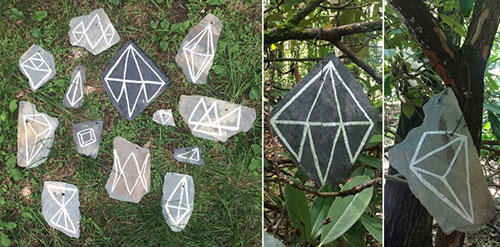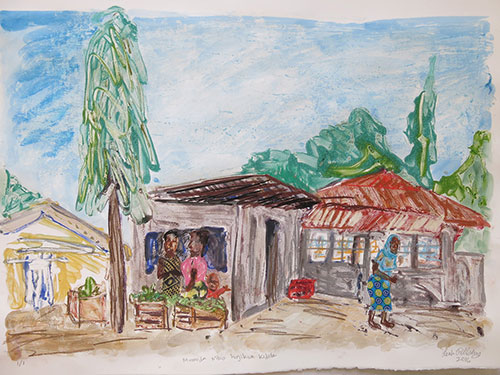2018 Artists
Meet the artists participating in the 2018 Community Supported Art program:

Jessica Caponigro
Before receiving her MFA from the School of the Art Institute of Chicago, Jessica Caponigro attended Bryn Mawr College where she earned her BA in the History of Art. In her interdisciplinary practice, Caponigro blends egalitarian concepts with ritual, and explores ideas of restriction through repetition, reproduction, and accessibility. Before its dissolution, she was a member of the non-anonymous W.I.T.C.H. Chicago collective as well as the feminist art collective Tracers. She frequently participates in workshops, most recently at the Museum of Contemporary Art in Chicago and NYU Florence. She currently lives and works in Boston, Massachusetts, where she operates Snake Hair Press, an independent publisher of prints, zines, and artist books. For Community Supported Art, she plans to create small sculptural talismans using screen printed patterns made of sigils and healing and protective materials, such as hematite, black tourmaline, sulfur, sage.
Emily Cobb
Emily Cobb’s art work is grounded in direct painting and drawing, though it often crosses into performance, installation, and video. She enjoys the storybook qualities of watercolor and woodcut and uses theatrical components in both her visual and performative work. In addition to her studio work, Emily produces a podcast called Hot Bath, writes for the Hassle, and is a seasoned professional gardener. Her art aims to provide shelter for subtle sensory experiences and an open receptive quality of contemplation. She strives to affect spaces, both physically and emotionally, and provides opportunities for reflection, affirmation and growth, play for the disenchanted, friendliness and curiosity toward the mutable self. Her project for Community Supported Art is a limited edition artist book. The pages would be printed from woodblocks and be hand-bound.
Xian Ho
Ho’s work in the past decade can be broadly categorized as still-life, but perhaps more accurately, portraiture—not of a person, but of fruits and vegetables. Partly inspired by the raw, local produce movement, her projects have focused largely on personified produce, with each fruit and vegetable essentially embodying its own unique identity and a life. She seeks to convey beauty in things that may not fit the conventional definition of beauty, like an "ugly tomato," and hopes the human viewer can relate on some level to non-human subjects depicted in her work. For Community Supported Art, she envisions creating miniature paintings on wood in the spirit of "rebirth," which is a theme she has started exploring in the past year in the context of rotting fruits and vegetables. She will pick as the topic of these works, fruits and vegetables that are grown in the farms of New England, such as cranberries and apples, staying true to the local "art share" concept.
Peter McCarthy
McCarthy makes kiln-formed glass art and functional objects, focusing on the color and light transmission of this magical material. He continually experiments with new techniques to expand his artistic expression and technical development. In the last few years, he has focused on combining murrine construction, fusing, and cold-working to create glass mosaic pieces. His project for Community Supported Art is to create a series of murrine mosaic plates. Each piece will be a unique functional artwork.
Susan Murie
Susan Murie has been an artist for over 40 years, working in film, video, photography, and currently with cyanotypes, a hybrid of photography and printmaking. She hand applies a cyanotype solution to fine art papers to make archival prints. Subjects of her explorations are conceptual, botanical, nature and reliquaries. Her work ranges in size from 8"x8" to 54" x 40". This year she creating a collection/installation of Kintsugi washi paper flower pieces with a take on a traditionally based repair ritual using gold ink. "Translated to “golden joinery,” Kintsugi (or Kintsukuroi, which means “golden repair”) is the centuries-old Japanese art of fixing broken pottery with a special lacquer dusted with powdered gold, silver, or platinum" (quote from mymodernmet.com). Another project will be an exploration, in cyanotype, of large horizontal branches and their blossoms. And for the first time she is exploring figurative forms with her cyanotype work. For Community Supported Art, she plans to create 8" x 11.5" botanical/conceptual pieces on cotton/linen paper. They would all be of a similar theme, but each print will be unique, one-of-a-kind.

Leah Pillsbury
Leah Pillsbury is a mixed media artist originally from Los Angeles, California. Her work is heavily influenced by where she is and the places she has lived before, including Tanzania, Kenya, India, Ecuador, Chile, Israel, Bolivia, and most recently, Washington, D.C. The iterative process of moving to new places and starting over in different political and social environments plays a strong role in her prints, drawings, photographs, ceramics, and papier-maché sculptures. In September 2016, she moved to Boston to attend graduate school. She is studying mechanical engineering at Boston University as a career pivot from diplomacy. She continues her artistic practice at the Artisans Asylum where she runs the print shop and teaches screenprinting classes.
For Community Supported Art, her project is a series of limited-edition prints. She wants to continue exploring how her different homes across the globe have contributed to her current sense of home and belonging. She may expand the proverb idea to include a whole series of various cultures' wisdom, or use this as a jumping off point to explore other themes of connectedness across space and cultural background.
Cory Shea
Cory Shea is a multimedia artist. Most recently her work is focused on the theme of the “Worry Dolls.” She explains: “The ‘Worry Doll’ series turned my nighttime anxiety into artwork. When I can’t sleep at night (with a scrolling to-do list of what has to get done), I find myself generating these collages in order to relax my mind. What starts with thoughts of ‘Did I pay my car insurance?’ Turns into nightmarish reflections of what is currently happening in the world and how helpless I feel. I’ve always been this way, the worries just have gotten greater. My Mom gave me my first box of Worry Dolls to stick under my pillow and I remember telling each one a fear or worry while I tried to relax. Once a worrier - always a worrier.” Her work is a reflection of those intricate fears, and how they collide and build onto each other. She represents that by layering digital imagery on top of each other. She prints the images and then adds in textural elements, because she believes people worry in just more than one dimension. For Community Supported Art, she is interested in creating hand-made ceramic tiles, transferring her digital images to these tiles, and then adding on organic shapes and textures.